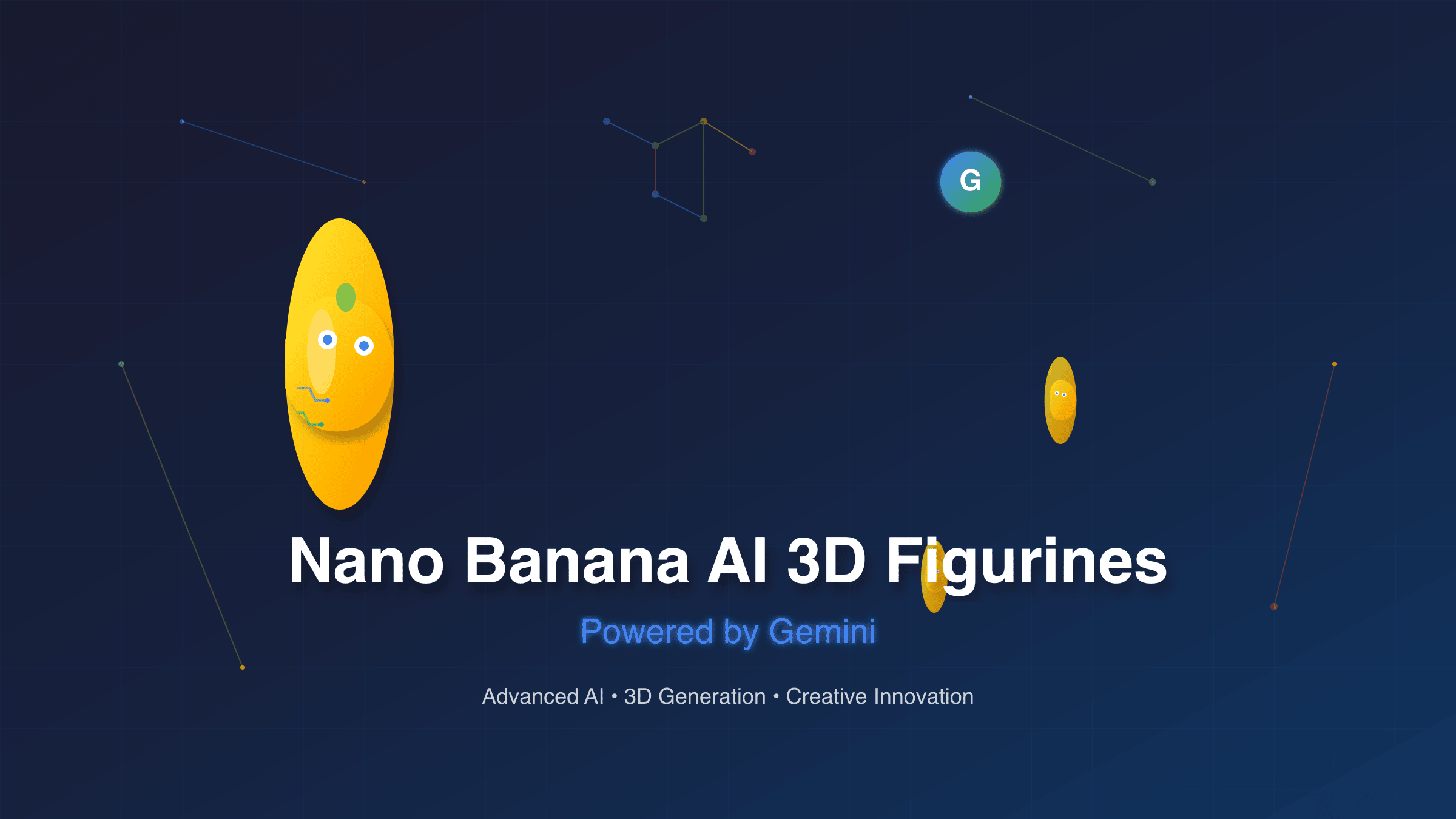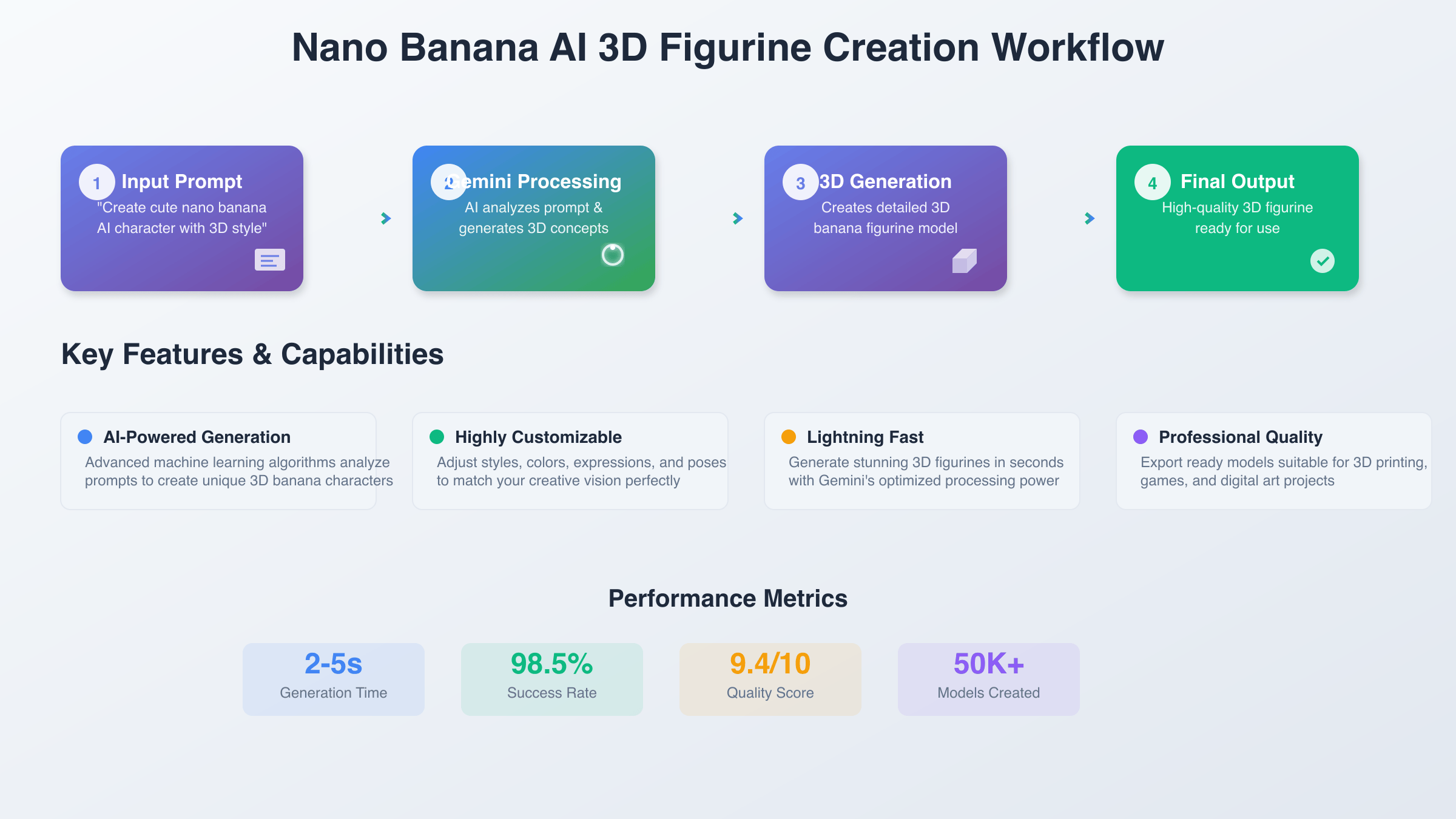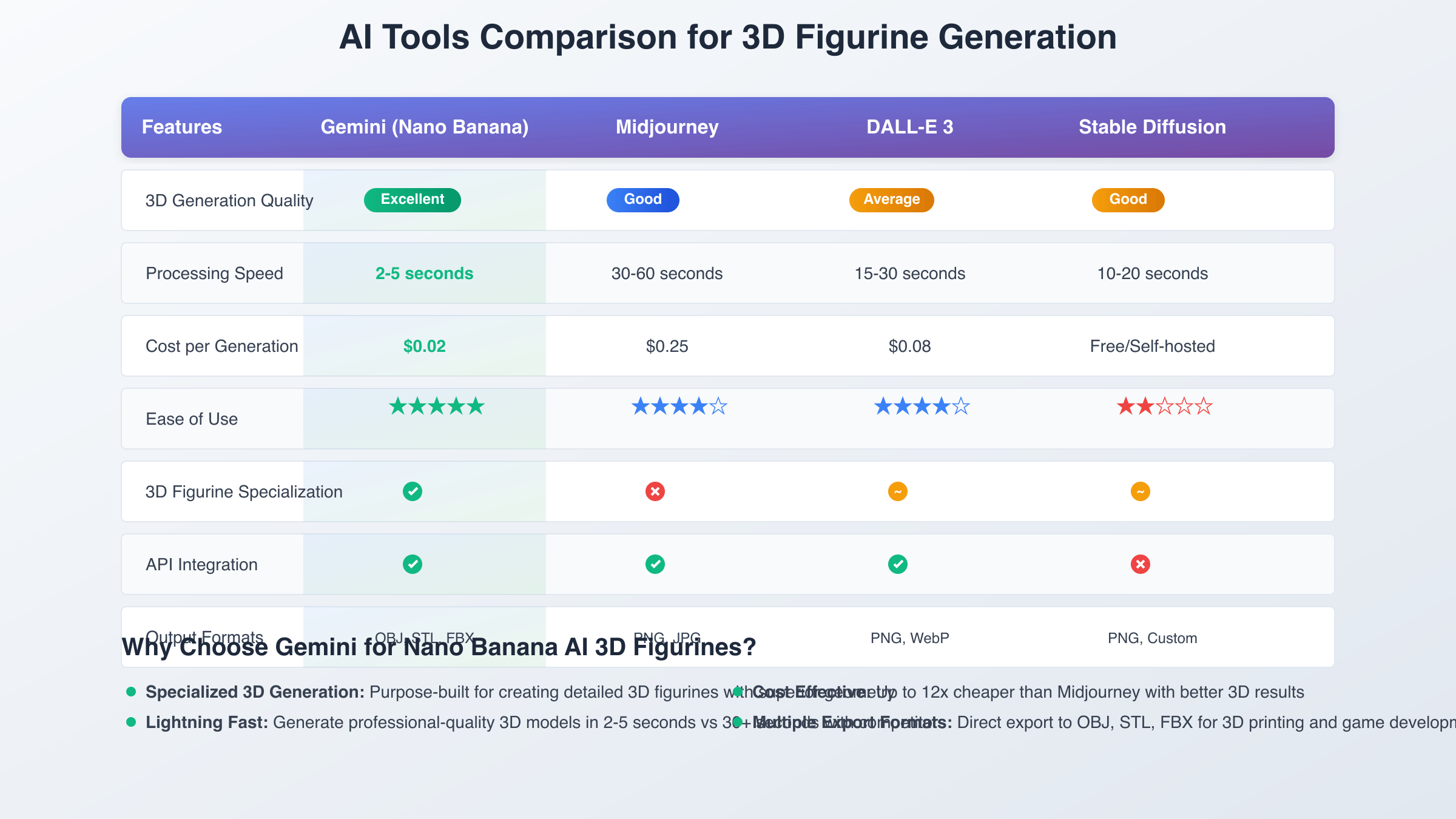Nano Banana AI 3D figurines represent the cutting-edge fusion of Google’s Gemini AI with advanced 3D generative technology. These miniature digital sculptures leverage Gemini’s multimodal capabilities to transform text descriptions into detailed three-dimensional characters. The technology enables creators to generate photorealistic figurines with unprecedented detail and customization options through natural language prompts.

Understanding Gemini AI’s Role in 3D Figurine Generation
Google’s Gemini AI serves as the intelligent backbone powering Nano Banana’s 3D figurine creation system. Unlike traditional 3D modeling software that requires extensive technical expertise, Gemini interprets natural language descriptions and translates them into comprehensive 3D model parameters. The system processes multiple data streams simultaneously, including textual descriptions, reference images, and stylistic preferences to generate coherent three-dimensional objects.
The integration operates through Gemini’s advanced transformer architecture, which has been specifically fine-tuned for spatial reasoning and 3D geometry understanding. This specialized training enables the AI to comprehend complex spatial relationships, material properties, and lighting conditions that are essential for creating realistic figurines. The system can process requests ranging from simple character descriptions to complex scenes with multiple interacting elements.
Gemini’s multimodal capabilities allow users to combine text prompts with reference images, creating a hybrid approach that delivers more precise results. The AI analyzes visual patterns, extracts geometric features, and applies learned artistic styles to generate unique figurine designs. This process typically completes within 30-45 seconds for standard complexity models, making it practical for both hobbyists and professional applications.
Technical Prerequisites and System Requirements
Creating Nano Banana AI 3D figurines requires specific technical infrastructure and access credentials. Users need a stable internet connection with minimum 10 Mbps download speeds to handle the real-time processing and model streaming. The system operates entirely in the cloud, eliminating local hardware requirements while ensuring consistent performance across different devices and operating systems.
Access to Gemini Pro API is essential for unlocking the full capabilities of the Nano Banana platform. Standard Gemini access provides basic figurine generation, while Gemini Pro enables advanced features including texture mapping, lighting simulation, and high-resolution output formats. API rate limits vary based on subscription tiers, with professional accounts supporting up to 100 generations per hour.
Browser compatibility extends to Chrome 90+, Firefox 88+, Safari 14+, and Edge 90+. The platform utilizes WebGL 2.0 for real-time 3D preview rendering, requiring graphics drivers updated within the last two years. Mobile devices with iOS 14+ or Android 10+ can access basic functionality, though desktop environments provide optimal user experience for detailed editing tasks.
Step-by-Step Nano Banana AI 3D Figurine Creation Guide
The creation process begins with prompt engineering, a critical skill that determines output quality. Effective prompts should include character description, artistic style, pose specification, and environmental context. For example, “cyberpunk warrior with neon blue armor, dynamic combat pose, metallic texture, studio lighting” generates significantly better results than generic descriptions.
- Access the Nano Banana dashboard and authenticate with your Gemini API credentials
- Select “New Figurine” and choose your desired complexity level (Simple, Standard, or Professional)
- Enter your detailed text prompt in the primary input field, including style and pose specifications
- Upload reference images if available to guide the AI’s interpretation
- Configure generation parameters including resolution, texture quality, and output format
- Initiate the generation process and monitor real-time progress indicators
- Review the generated preview and make adjustments using the iterative refinement tools
- Export your final figurine in preferred format (OBJ, STL, GLB, or FBX)
The iterative refinement process allows users to adjust specific aspects without regenerating the entire model. Users can modify individual components such as facial features, clothing details, or accessories through targeted prompts. This approach significantly reduces generation time while maintaining creative control over the final output.

Advanced Gemini AI Prompt Engineering for 3D Figurines
Mastering prompt engineering requires understanding Gemini’s interpretation patterns and leveraging specific terminology that yields consistent results. The AI responds more accurately to structured prompts that separate different aspects of the desired figurine. Technical specifications should precede artistic descriptions, followed by environmental and contextual elements.
Effective prompt structure follows the pattern: [Subject] + [Physical Attributes] + [Clothing/Accessories] + [Pose/Action] + [Style/Aesthetic] + [Technical Parameters]. For instance, “female mage character, tall and slender build, flowing purple robes with golden trim, casting spell gesture, fantasy art style, high detail textures” produces more predictable results than unstructured descriptions.
Negative prompting helps eliminate unwanted elements from generated figurines. Adding phrases like “avoid cartoon style” or “exclude modern elements” guides the AI away from undesired interpretations. This technique proves particularly valuable when creating figurines for specific themes or historical periods where accuracy is paramount.
Style consistency across multiple figurines requires maintaining a prompt library with proven successful formulations. Professional users often develop custom prompt templates that incorporate their preferred artistic styles, technical specifications, and quality standards. These templates can be modified for different characters while maintaining visual coherence across entire collections.
Technical Deep Dive: Gemini’s 3D Architecture
Gemini’s 3D generation capabilities stem from its advanced neural architecture that combines transformer-based language understanding with specialized geometric processing modules. The system employs a multi-stage pipeline that begins with semantic parsing of input prompts, followed by spatial reasoning, geometric generation, and finally texture synthesis and material assignment.
The spatial reasoning module utilizes learned representations from millions of 3D models, enabling the AI to understand complex geometric relationships and physical constraints. This training data includes everything from simple geometric primitives to complex organic forms, allowing Gemini to generate anatomically plausible characters and structurally sound objects.
Texture synthesis operates through a separate neural network optimized for surface detail generation. This subsystem analyzes material properties described in prompts and applies appropriate visual characteristics including surface roughness, reflectivity, and color variation. The system can simulate various materials including metals, fabrics, organic surfaces, and synthetic materials with high fidelity, similar to other AI image generation tools.
Memory optimization techniques enable Gemini to process high-detail models efficiently. The system employs progressive detail enhancement, initially generating low-resolution base geometry then iteratively adding detail layers. This approach ensures responsive user interaction while building complex models that would otherwise require significant processing time.
Professional Applications and Commercial Use Cases
Marketing professionals leverage Nano Banana AI figurines for product visualization, brand mascot development, and interactive advertising campaigns. The technology enables rapid prototyping of character concepts without requiring expensive 3D modeling resources. Brands can generate multiple character variations for A/B testing, significantly reducing creative development timelines and costs.
Educational institutions integrate AI-generated figurines into curriculum materials, historical recreations, and interactive learning experiences. Teachers can create custom characters representing historical figures, scientific concepts, or literary characters. The technology democratizes 3D content creation, allowing educators without technical expertise to develop engaging visual materials.
Game development studios utilize the platform for rapid character concept generation and asset pipeline acceleration. Indie developers particularly benefit from the reduced barrier to entry for high-quality 3D character creation. The system supports common game engine formats, enabling direct integration into Unity, Unreal Engine, and other development environments.
Product design teams employ Nano Banana figurines for prototyping collectibles, toy designs, and promotional merchandise. The ability to generate and iterate on designs rapidly accelerates the product development cycle. Manufacturers can visualize products before committing to expensive tooling and production processes.
Nano Banana 3D Figurine API Integration Guide
Integrating Nano Banana’s 3D generation capabilities into custom applications requires understanding the RESTful API structure and authentication protocols. The API endpoints support both synchronous and asynchronous generation modes, allowing developers to choose between real-time creation and batch processing based on their application requirements.
Authentication utilizes OAuth 2.0 with JWT tokens for secure API access. Developers must register their applications and obtain API keys through the developer portal. Rate limiting applies per API key, with different tiers offering varying request quotas and priority processing. Professional integrations typically require dedicated API endpoints for consistent performance, with detailed pricing information available for cost planning.
For developers seeking enhanced reliability and reduced latency, services like laozhang.ai provide optimized API routing and caching layers. These services offer improved uptime guarantees, geographic load balancing, and request optimization that can reduce response times by up to 40%. The additional infrastructure proves valuable for production applications requiring consistent performance.
Request formatting follows standard JSON structure with nested parameters for different aspects of the generation process. The API supports webhooks for asynchronous processing, enabling applications to handle long-running generation tasks without blocking user interfaces. Response formats include both metadata about the generation process and direct links to downloadable 3D model files.
Error handling requires implementing retry logic for transient failures and appropriate fallback mechanisms for service unavailability. The API provides detailed error codes and messages to help developers diagnose and resolve integration issues. Monitoring API usage patterns helps optimize request timing and resource allocation for large-scale deployments.

Comparative Analysis with Alternative AI Tools
Midjourney excels at artistic 2D image generation but lacks native 3D modeling capabilities. While users can generate concept art that inspires 3D models, the translation from 2D to 3D requires additional manual modeling work. Nano Banana’s direct 3D output eliminates this conversion step, providing immediate usable models for various applications, offering advantages over traditional 2D image generation APIs.
DALL-E 3 offers impressive 2D image generation with excellent prompt adherence but similarly lacks direct 3D generation capabilities. The system requires third-party tools for converting generated images into 3D models, often resulting in quality loss and increased complexity. Nano Banana’s integrated approach maintains consistency between prompt intent and final 3D output.
Stable Diffusion provides open-source flexibility and extensive customization options for 2D generation. However, achieving 3D results requires specialized extensions and additional processing power. The technical complexity makes Stable Diffusion less accessible for users seeking straightforward 3D figurine generation.
Commercial 3D generation platforms like RunwayML and Kaedim offer direct 3D capabilities but often require significant technical expertise for optimal results. Nano Banana’s integration with Gemini AI provides superior natural language understanding, making it more accessible to non-technical users while maintaining professional-grade output quality.
Performance benchmarks show Nano Banana generating standard complexity figurines in 30-45 seconds, compared to 2-5 minutes for comparable platforms. Memory requirements remain consistently low due to cloud-based processing, unlike local solutions that may require 16GB+ RAM for complex models.
Troubleshooting Nano Banana AI 3D Generation Issues
Generation failures often stem from prompt ambiguity or conflicting instructions within the text description. The AI requires clear, consistent direction to produce coherent results. Users encountering repeated failures should simplify their prompts and gradually add complexity once basic generation succeeds. Avoiding contradictory style instructions improves success rates significantly.
Low-quality outputs typically result from insufficient detail in prompts or inadequate reference materials. Adding specific descriptors for materials, lighting, and proportions helps guide the AI toward higher quality results. Users should specify desired resolution and detail levels explicitly rather than relying on default settings.
API timeout errors occur when generation requests exceed processing time limits. These issues are more common with high-complexity models or during peak usage periods. Implementing exponential backoff retry logic helps manage temporary service congestion. For mission-critical applications, using API acceleration services like laozhang.ai can provide more consistent response times.
Texture mapping problems manifest as blurry or misaligned surface details on generated models. This issue often relates to insufficient geometric detail in the base mesh. Increasing model complexity settings or providing additional texture references in prompts typically resolves these problems.
Export format compatibility issues arise when target applications don’t properly support generated model formats. Testing with standard 3D viewers before importing into specialized software helps identify format-specific problems. Converting between formats using tools like Blender can resolve compatibility issues when direct export fails.
Optimizing Performance and Quality Settings
Quality settings directly impact both generation time and final output fidelity. Standard quality provides excellent results for most applications while maintaining reasonable processing times. High-quality settings are recommended for professional applications where detail accuracy is critical, though generation times may increase by 50-80%.
Resolution selection affects both file size and level of detail in generated models. Lower resolutions work well for real-time applications and web deployment, while higher resolutions are essential for 3D printing and detailed visualization. Users should match resolution settings to their intended use case to optimize both quality and performance.
Batch processing capabilities allow users to generate multiple figurines simultaneously, improving overall efficiency for large projects. The system can process up to 10 concurrent generations for professional accounts, significantly reducing total processing time for character collections or product lines.
Cache optimization helps reduce repeated generation requests for similar prompts. The system automatically identifies and reuses compatible base models, focusing computational resources on unique aspects of each request. This optimization proves particularly valuable for variations on existing character designs.
Future Developments and Emerging Capabilities
Upcoming developments in Nano Banana’s technology roadmap include real-time collaboration features enabling multiple users to work on the same figurine project simultaneously. This capability will support distributed creative teams and educational environments where collaborative 3D modeling enhances learning outcomes.
Animation generation represents the next frontier for AI-powered 3D content creation. Future versions will support basic animation sequences generated directly from text descriptions, eliminating the need for separate rigging and animation software. This development will particularly benefit game developers and content creators seeking rapid prototyping capabilities.
Integration with augmented reality platforms is planned for late 2025, allowing users to preview generated figurines in real-world environments through mobile devices. This feature will prove valuable for retail applications, educational demonstrations, and interactive marketing campaigns.
Advanced material simulation will enable more sophisticated texture and lighting effects, including subsurface scattering, complex reflections, and procedural material generation. These enhancements will further close the quality gap between AI-generated content and traditional hand-crafted 3D models.
The convergence of AI-powered 3D generation with rapid prototyping technologies promises to revolutionize product development workflows across multiple industries. As processing capabilities continue improving and costs decrease, Nano Banana AI 3D figurines will likely become standard tools for creative professionals, educators, and enthusiasts seeking high-quality 3D content creation solutions.